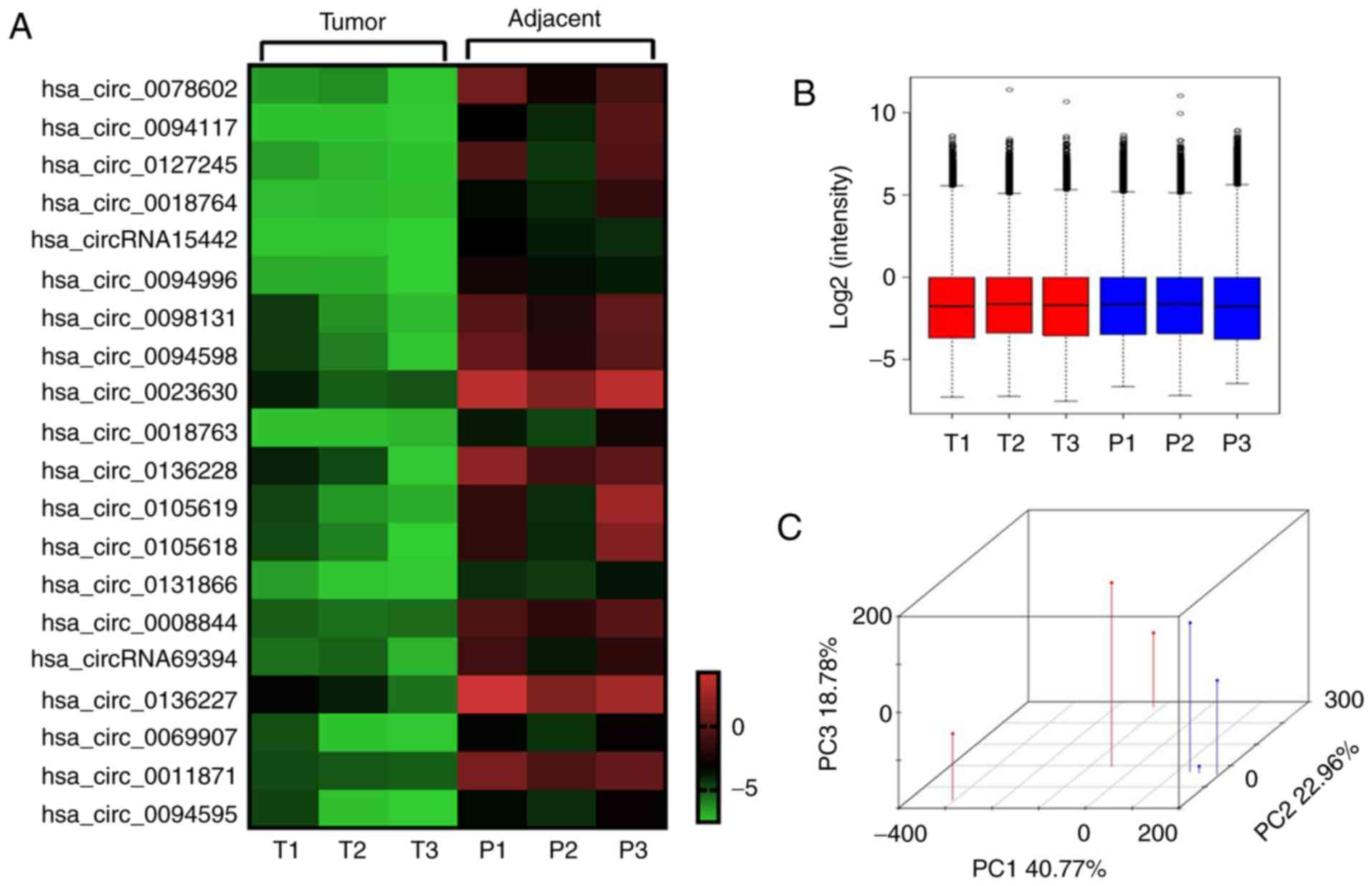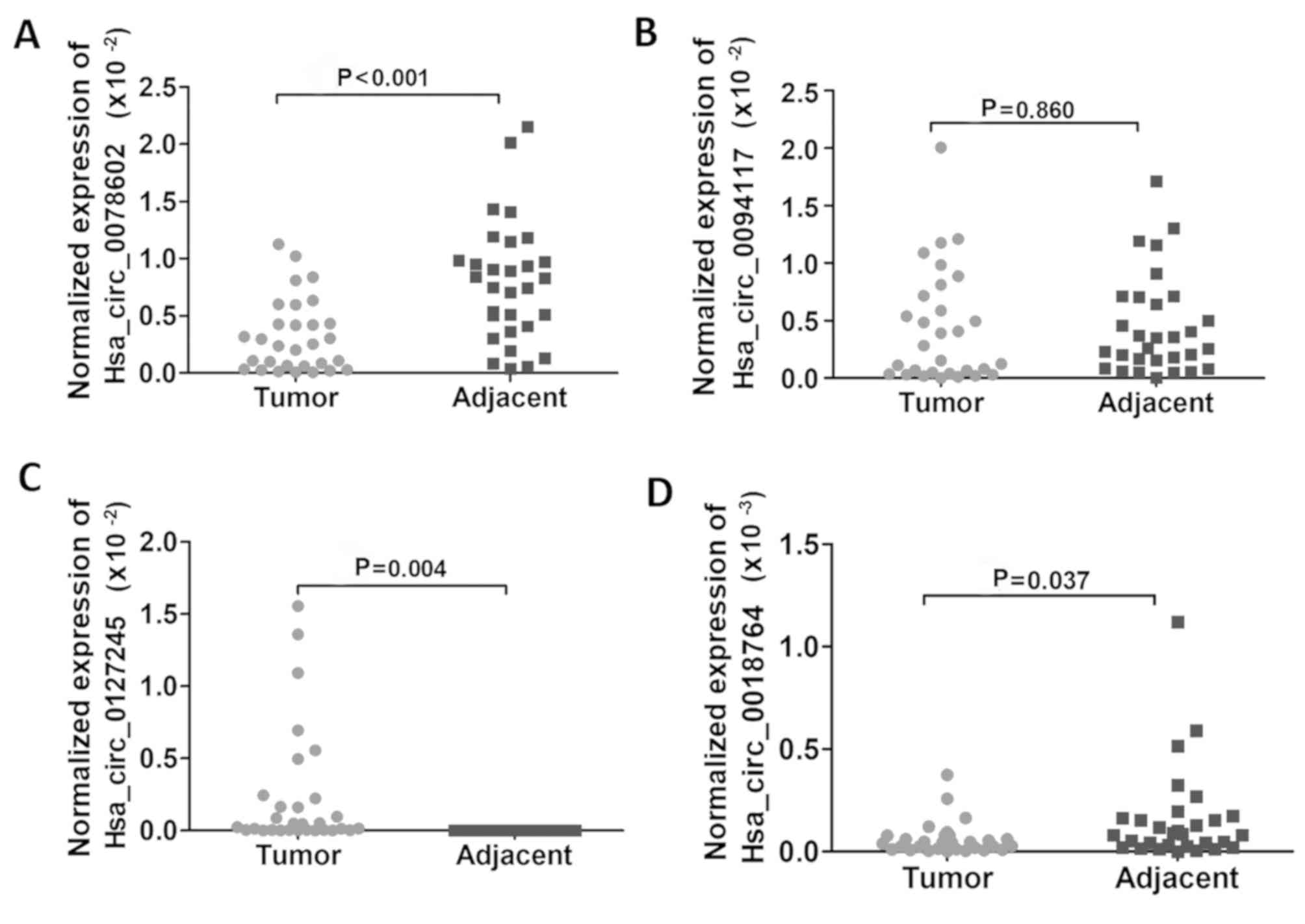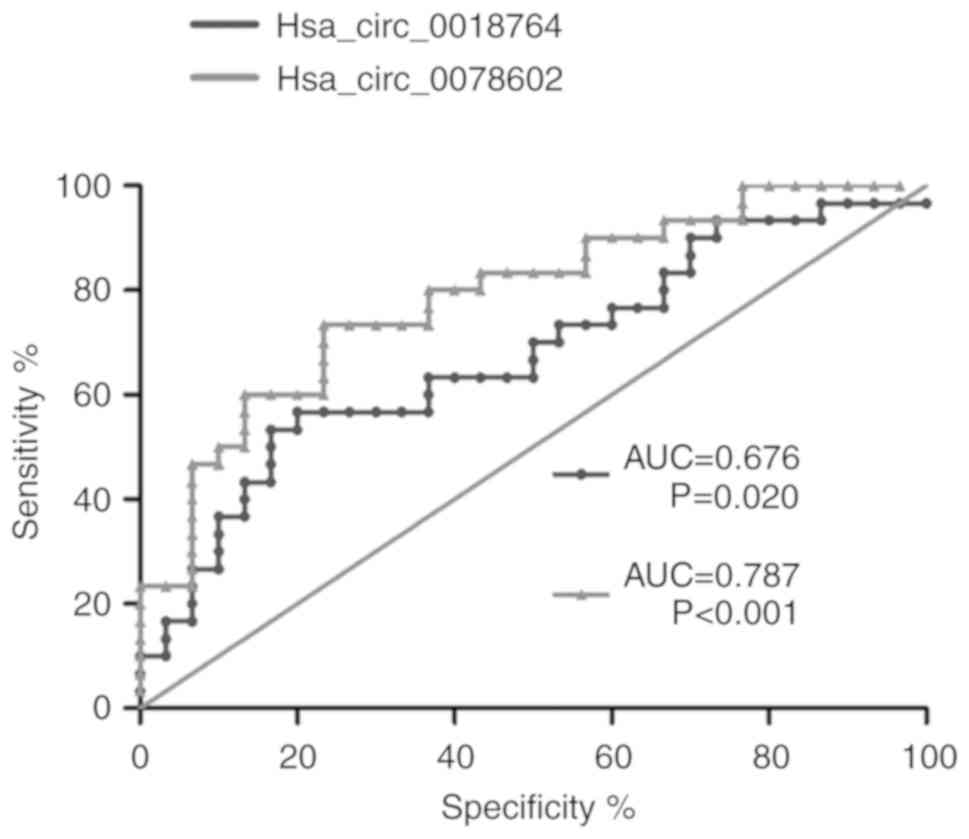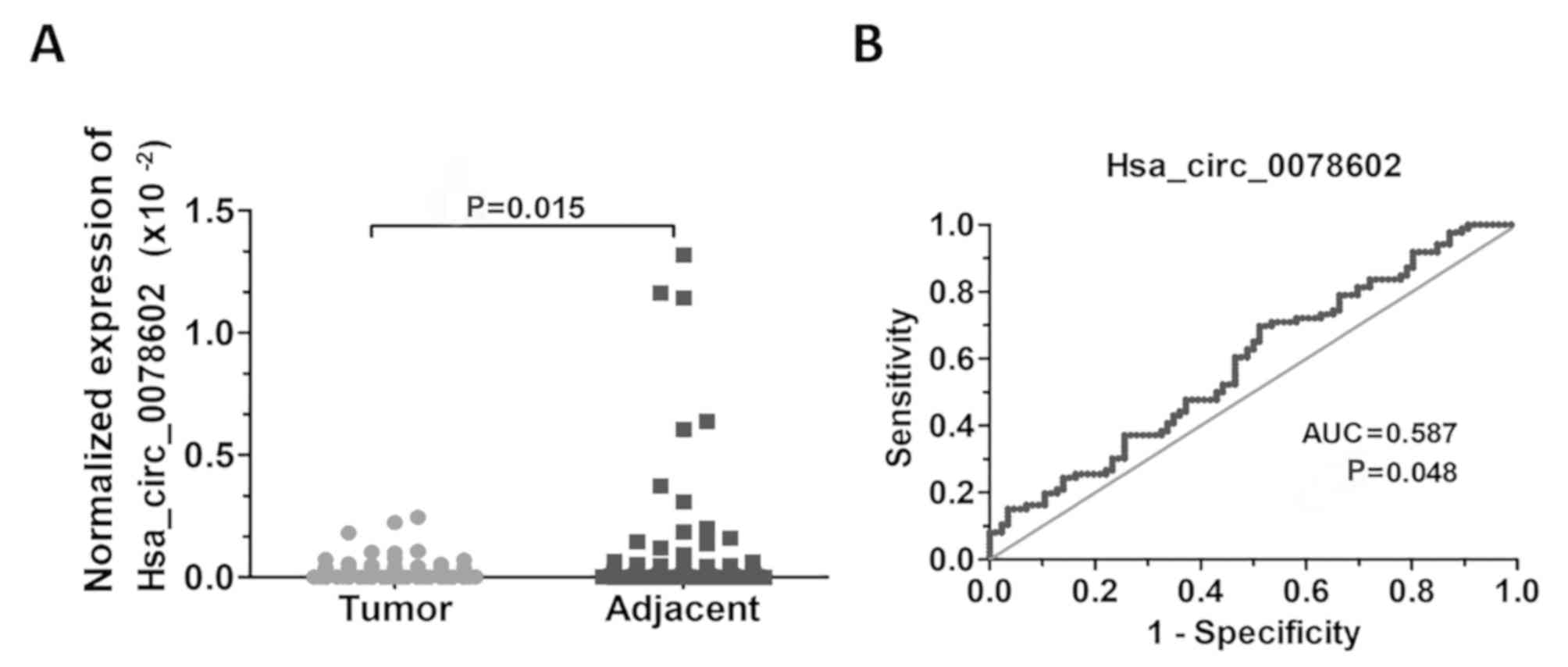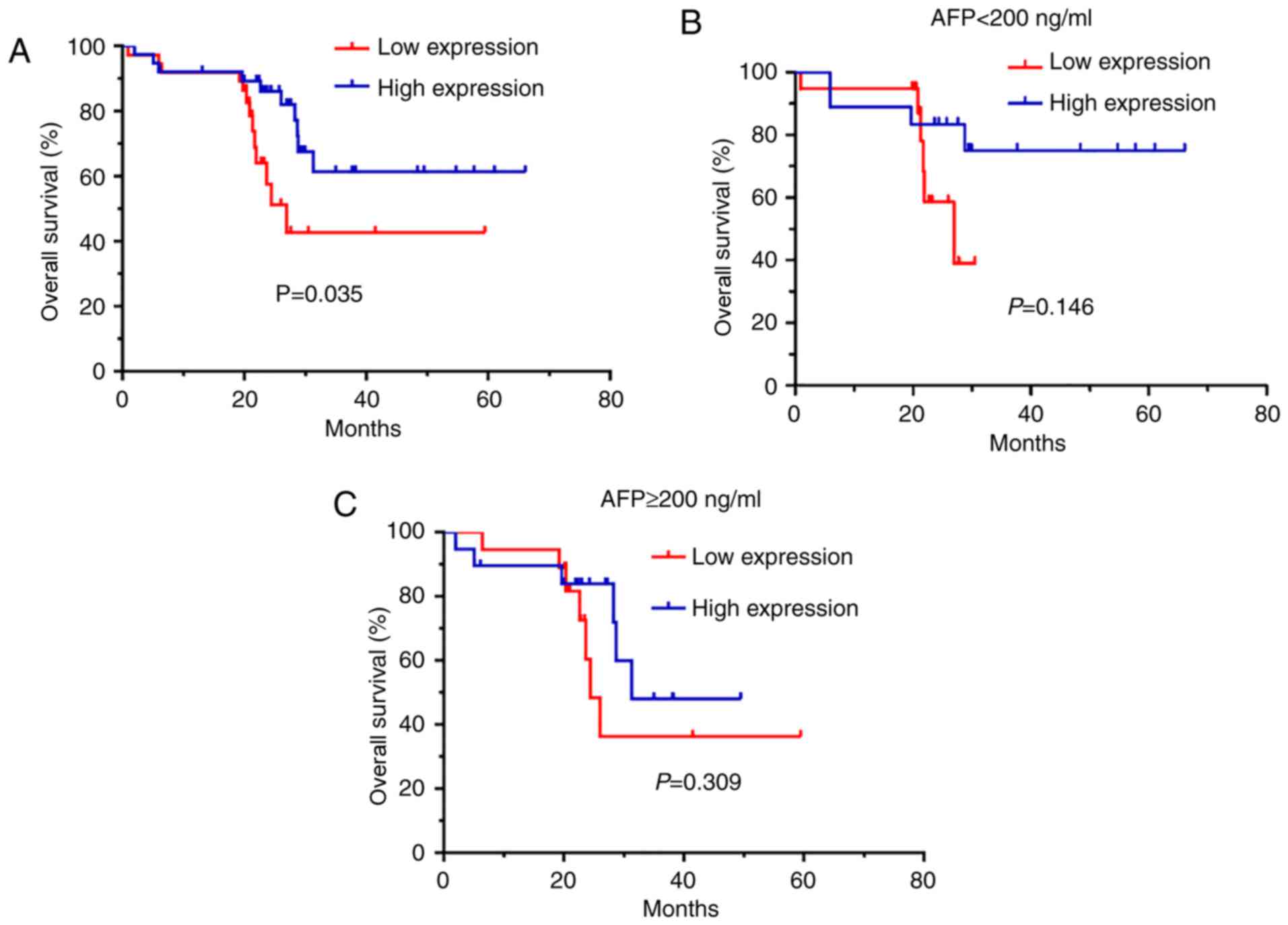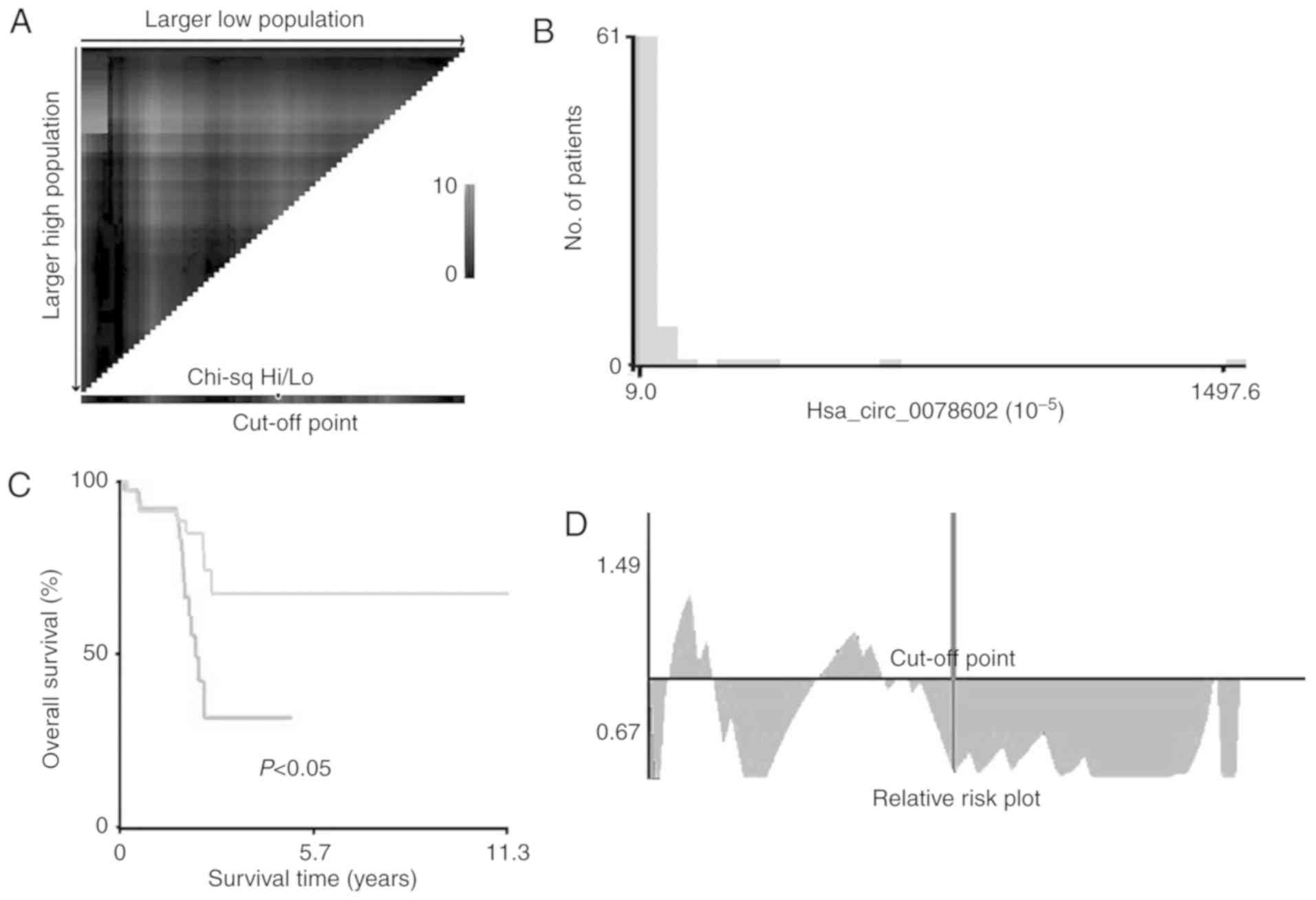Circular RNA hsa_circ_0078602 may have potential as a prognostic biomarker for patients with hepatocellular carcinoma
- Authors:
- Published online on: December 21, 2018 https://doi.org/10.3892/ol.2018.9863
- Pages: 2091-2098
-
Copyright: © Kou et al. This is an open access article distributed under the terms of Creative Commons Attribution License.
Abstract
Introduction
Circular RNAs (circRNAs) are a type of non-coding RNA that was first discovered by Sanger in a virus using electron microscopy in the 1970s (1). These molecules have a closed loop structure with no 5′-terminal cap or 3′-terminal poly(A) tail. This unique structure protects circRNAs from rapid degradation by exonucleases (2). CircRNAs have subsequently been identified in other organisms (3–6). Previously, these molecules were considered to be byproducts of aberrant RNA splicing and few studies have investigated circRNAs due to their low abundance and lack of known functions. Due to the rapid development of bioinformatics and RNA deep sequencing technology, an increased number of studies investigating circRNAs have been conducted in recent decades. CircRNAs are now thought to be endogenous, abundant, stable and conserved in mammalian cells (2), and they have been reported to have considerable biological function (7,8).
CircRNAs perform their functions through various mechanisms. For instance, cerebellar-degeneration-related protein 1 antisense RNA (CDR1as) serves as competing endogenous RNA or a microRNA (miRNA) sponge to regulate gene expression by reducing the inhibitory effect of miRNA on its target gene (9). Additionally, previous studies have identified that circRNAs may regulate parental gene expression by binding to the RNA polymerase II transcription complex (10,11). In addition, recent studies have demonstrated that circRNAs also bind with certain proteins (12) and DNA (13) to regulate downstream signaling. An increasing number of studies have revealed that circRNAs are involved in many diseases, including atherosclerosis (14), heart failure (15), Alzheimer's disease (16), diabetes (17), osteoarthritis (18) and cancer (19). Although a number of studies on cancer-associated circRNA have been performed (19–21), the function and clinical value of circRNAs in hepatocellular carcinoma (HCC) remain to be investigated.
The current study analyzed differential circRNA expression between HCC tissues and adjacent non-cancerous tissues, and validated the results of microarray analysis. Finally, hsa_circ_0078602 was identified as having decreased expression in HCC tissues and being closely associated with the prognosis of patients with HCC. The current study also demonstrated the diagnostic potential of hsa_circ_0078602. Decreased expression of hsa_circ_0078602 in HCC tissue may act as a biomarker for diagnosis and prognosis prediction, and may also serve as a potential therapeutic target for HCC.
Materials and methods
Patients and tissue samples
HCC tissue samples and adjacent normal liver tissue samples were collected from 79 patients who underwent surgery at Fudan University Shanghai Cancer Center, between January 2011 and December 2015. The cohort consisted of 70 (88.6%) males and 9 (11.4%) females, with 56 (70.9%) of the patients being <60 years old. All patients were pathologically diagnosed with HCC and provided written informed consent before sample collection. Patients with severe disorders of major organs or a history of any other tumors were excluded. Information on the serum α-fetoprotein (AFP) levels, measured prior to surgery using ELISA, was obtained from the medical records of the patients. The overall survival (OS) time was calculated from the date of diagnosis to the date of mortality or the last known follow-up date. Following tissue procurement, the samples were immediately stored at −80°C until further experiments. The present study was approved by the Ethics Committee of the Shandong Cancer Hospital Affiliated to Shandong University (Jinan, China).
RNA isolation and circRNA microarray analysis
Total RNA was extracted from HCC tissue and adjacent non-cancerous tissue using TRIzol reagent (Invitrogen; Thermo Fisher Scientific, Inc., Waltham, MA, USA) according to the manufacturer's protocol and RNA integrity was determined with agarose gel electrophoresis (1% gel). Qualified RNA was used for microarray detection or subsequent validation experiments. CapitalBio Corporation (Beijing, China) performed the circRNA microarray detection, with 6 samples (3 HCC and 3 paired non-cancerous samples). The CapitalBio Human CircRNA Array v2 was designed with 4 identical arrays per slide (4×180,000 format), with each array containing probes interrogating ~170,340 human circRNAs, selected based on known circRNA sites included in CircBase (http://www.circbase.org/) and deepBase (http://rna.sysu.edu.cn/deepBase/). The circRNA array data was analyzed using GeneSpring software (version 13.0; Agilent Technologies, Inc., Santa Clara, CA, USA). Threshold values of ≥2 and ≤-2-fold change, and P<0.05 were used to select the differentially expressed genes.
Reverse transcription-quantitative polymerase chain reaction (RT-qPCR)
Complementary DNA was synthesized by RT using the RNA-to-cDNA kit (Takara Bio, Inc., Otsu, Japan), according to the manufacturer's protocol. The relative expression of circRNA was determined using the ABI Prism 7900 Sequence Detection system (Applied Biosystems; Thermo Fisher Scientific, Inc.). The qPCR assay was conducted using a SYBR Green kit (Takara Bio Inc., Otsu, Japan), with the following thermocycling conditions: 45 cycles consisting of denaturation at 95°C for 5 sec, annealing at 60°C for 30 sec and extension at 72°C for 30 sec. A housekeeping gene, GAPDH, was used as a control and RNA enrichment was analyzed using the 2−ΔΔCq method (22). All primers were synthesized by ThinkGene Biotech Co., Ltd. (Shanghai, China). The primer sequences are listed in Table I.
Statistical analysis
All statistical analyses were performed using SPSS software (version 19.0; IBM Corp., Armonk, NY, USA) and GraphPad Prism software (version 5.0; GraphPad Software, Inc., La Jolla, CA, USA). Differences in circRNA expression between HCC and paired non-cancerous tissues were assessed using the paired t-test. A receiver operating characteristic (ROC) curve and the area under the curve (AUC) was used to assess diagnostic power. Survival curves were obtained using the Kaplan-Meier method and the differences between the curves were analyzed using a log rank test. X-tile (version 3.5.0 software; http://medicine.yale.edu/lab/rimm/research/software.aspx) was used to analyze the optimal cut-off value of hsa_circ_0078602 expression. P≤0.05 was considered to indicate a statistically significant difference.
Results
Dysregulated circRNAs in HCC tissues relative to non-cancerous tissues
To explore differentially expressed circRNAs in HCC tumor tissue and adjacent non-tumor liver tissue, tissue samples from 3 patients were selected to perform circRNA microarray detection. Downregulated circRNAs in HCC tissue were of most interest, therefore the 20 circRNAs with the most suppressed expression in HCC tissues are presented in Fig. 1A. As demonstrated in Fig. 1B, the expression levels of global genes in the probe in different samples after standardization exhibited similar levels. Principal component analysis was also conducted to reflect the similarity of samples (Fig. 1C).
Validation of circRNA microarray results
Among circRNAs identified to be present at decreased levels in HCC tissue compared with non-cancerous tissue, the four most suppressed examples (hsa_circ_0078602, hsa_circ_0094117, hsa_circ_0127245 and hsa_circ_0018764) were selected for further verification experiments. The expression of these four circRNAs in HCC and paired non-cancerous tissues from 30 patients was analyzed by RT-qPCR (Fig. 2). It was identified that the expression of hsa_circ_0078602 and hsa_circ_0018764 were significantly and consistently decreased in HCC tissues compared with matched samples (Fig. 2A and D). However, there was no significant difference in the expression of hsa_circ_0094117 between the tumor and the healthy tissues (Fig. 2B). Furthermore, the expression of hsa_circ_0127245 was increased in the tumor tissue compared with the adjacent tissue, in contradiction to the microarray result (Fig. 2C). As the reason for this inconsistency required clarification with further testing, hsa_circ_0127245 was not used in subsequent experiments. Next, the clinical role of hsa_circ_0078602 and hsa_circ_0018764 in patients with HCC was investigated. The potential diagnostic effect of hsa_circ_0078602 and hsa_circ_0018764 in distinguishing HCC tumor tissues from neighboring non-cancerous tissues was examined by establishing an ROC curve (Fig. 3). The AUCs for hsa_circ_0078602 and hsa_circ_0018764 were 0.787 and 0.676, respectively, indicating that the former may have potential to be a diagnostic biomarker. Therefore, attention was focused on hsa_circ_0078602 for further study.
Next, the expression of hsa_circ_0078602 in HCC tumor tissues was confirmed in 79 patients with HCC; it was revealed to be significantly decreased in HCC tissues compared with adjacent non-cancerous tissues (Fig. 4A). In addition, hsa_circ_0078602 demonstrated good diagnostic efficacy (Fig. 4B). Although the AUC in Fig. 4B is 0.587, P<0.05 indicated statistical significance, indicating that hsa-circ-0078602 may have potential as a diagnostic biomarker. The clinicopathological characteristics of the 79 patients and the expression levels of hsa_circ_0078602 are presented in Table II.
Table II.Clinicopathological characteristics of the patients with hepatocellular carcinoma (n=79) and relative expression levels of hsa_circ_0078602. |
Low hsa_circ_0078602 expression is associated with poor survival outcome in patients with HCC
Since the expression level of hsa_circ_0078602 was significantly different between HCC tumor tissue and neighboring non-tumor tissue, the association of hsa_circ_0078602 expression with the survival of patients with HCC was investigated. Analysis was performed to assess the association between expression of hsa_circ_0078602 and overall survival of patients with HCC in 79 cases. Kaplan-Meier survival analysis was used and patients were divided into high and low hsa_circ_0078602 expression groups (P=0.035; Fig. 5A). The data suggested that patients with low hsa_circ_0078602 expression had significantly poorer survival outcomes. These analyses demonstrated that hsa_circ_0078602 expression level may have potential to predict the prognosis of patients with HCC. Next, the association between expression level of hsa_circ_0078602 and the clinical parameter, serum AFP was analyzed. Patients were stratified into two cohorts based on their level of serum AFP (<200 and ≥200 ng/ml). The difference of overall survival between high and low hsa_circ_0078602 expression groups within the two cohorts was investigated (Fig. 5B and C). No statistically significant difference was identified between the high and low expression groups in the <200 ng/ml (P=0.146), or the ≥200 ng/ml AFP cohort (P=0.309).
Analysis of optimum cut-off value of hsa_circ_0078602 expression
Finally, X-tile 3.5.0 software was used to calculate the optimal cut-off value of hsa_circ_0078602 expression, which could most robustly estimate outcomes of patients with HCC (Fig. 6). The data demonstrated that an hsa_circ_0078602 relative expression of 9.0×10−5 (normalized to housekeeping gene GAPDH) may be effective in predicting survival outcomes of patients with HCC. Patients with hsa_circ_0078602 relative expression levels <9.0×10−5 may exhibit a poor prognosis.
Discussion
On a global scale, primary liver cancer is a major contributor to both cancer incidence and cancer-associated cases of mortality (23). Liver cancer is the third most common type of cancer diagnosed in China (24) and is one of the leading causes of cancer-associated cases of mortality worldwide (25). HCC, the most common type of primary liver cancer, accounts for approximately 80 to 85% of primary liver cancer cases worldwide (26). With advancements in diagnostic and therapeutic approaches, certain patients with HCC could be diagnosed at an early stage and undergo radical surgery. Nonetheless, the prognosis of most patients with HCC remains unsatisfactory, mainly due to metastasis, recurrence or drug resistance (27,28). These clinical challenges promote studies to identify new biomarkers to diagnose HCC and reveal novel targets for the development of more effective therapies.
Currently, the roles of circRNAs in cancer have received widespread attention from researchers. For example, circRNAs have been revealed to be dysregulated in certain tumor types, including breast cancer (29), lung cancer (30), esophageal squamous cell carcinoma (31), gastric cancer (32) and colorectal carcinoma (33), and these circRNAs have been identified to be closely associated with tumorigenesis and tumor progression. However, to the best of our knowledge, the function of circRNAs in HCC is unknown. Rapid advancements in microarray analysis technology have promoted its widespread application in the study of non-coding RNA. The current study analyzed differential expression of circRNA between HCC tissues and adjacent non-cancerous tissues in three paired HCC samples using microarray analysis.
The results demonstrated that circRNA levels differed between HCC tissues and the adjacent normal tissues. Both upregulated and downregulated circRNAs were identified in HCC tissues compared with adjacent normal tissues. Following a relevant study that demonstrated that certain downregulated circRNAs may serve a role in hepatocellular carcinoma progression (34), the current study was more focused on downregulated circRNAs. To validate the results of microarray, RNA expression levels of the four most downregulated circRNAs were measured in a total of 30 matched HCC samples. As indicated by RT-qPCR, the levels of hsa_circ_0078602 and hsa_circ_0018764 were consistent with microarray analysis. Previous studies have suggested a potential role of circRNA as a biomarker in cancer diagnosis (35,36). Therefore, the current study explored the clinical value of circRNAs. Notably, the AUC of hsa_circ_0078602 was 0.787, demonstrating a favorable diagnostic efficiency, suggesting that further studies should be performed. The level of hsa_circ_0078602 was subsequently confirmed in 79 paired HCC tissues. The results demonstrated that the expression level of hsa_circ_0078602 in HCC tissue was significantly lower compared with non-cancerous tissue. These data suggest that hsa_circ_0078602 may be used as a novel biomarker that can contribute to the identification of HCC.
Next, it was identified that the decreased hsa_circ_0078602 expression in HCC tissue was significantly associated with a worse prognosis. The expression level of hsa_circ_0078602 in HCC tissues was significantly lower compared with adjacent non-cancerous tissues, which indicated that hsa_circ_0078602 acted as a tumor suppressor gene for carcinogenesis of HCC; the results of Kaplan-Meier analysis was consistent with this function. Considering the role of serum AFP in HCC diagnosis and efficacy evaluation, the current study investigated whether the association between circRNA and OS was affected by the level of serum AFP. However, no significant difference was identified in OS when patients were divided into two cohorts according to the level of serum AFP. It was speculated that there may be some uncertain connection between hsa_circ_0078602 and serum AFP, which requires further study. Finally, an optimal cut-off value of hsa_circ_0078602 (9.0×10−5) for the prognostic prediction was obtained using X-tile 3.5.0 software. Although the application of a circRNA cut-off value still needs to be confirmed in future studies, it is assumed that the hsa_circ_0078602 expression value of 9.0×10−5 may provide value in predicting the outcomes of patients with HCC.
To date, few studies have focused on the association between HCC and circRNA, particularly regarding function and possible mechanism. Yang et al (37) reported that CDR1as exerted an effect on the proliferation of HCC cells partly through regulation of epidermal growth factor receptor signaling via control of miR-7 expression, which provided a reliable and highly efficient method for globally identifying circRNA-regulated proteins. Using RNA-sequencing, Zheng et al (38) identified that a circRNA derived from exon 2 of homeodomain interacting protein kinase 3, termed circHIPK3, was differentially expressed in HCC and regulated human cell growth by directly binding to miR-124 and inhibiting miR-124 activity. Similarly, Han et al (34) revealed that mitochondrial translation optimization 1 homologue (circMTO1) expression was significantly decreased in HCC and associated with poor prognosis of patients with HCC. In addition, circMTO1 inhibited HCC growth via sponge activity on miR-9 and upregulation of p21 expression. These studies indicated that circRNA could regulate gene expression by serving as an miRNA sponge, which was confirmed in other previous studies (9,39). The circRNA identified in the current study (hsa_circ_0078602) was identified to be associated with prognosis of patients with HCC. Following a bioinformatics analysis to explore possible mechanisms, it was revealed that hsa_circ_0078602 is associated with several miRNAs, including hsa-miR-1207-5p, hsa-miR-6787-5p, hsa-miR-940, hsa-miR-1202, hsa-miR-4459 and hsa-miR-3194-5p, which have been identified to affect cell proliferation, cell cycle progression and apoptosis in tumor cell lines. The present study hypothesizes that hsa_circ_0078602 may affect the function of tumor cells via miRNA. The association between hsa_circ_0078602 and miRNA may be revealed and validated in further studies.
In conclusion, the current data demonstrated that hsa_circ_0078602 expression was significantly decreased in HCC and may be utilized as a circRNA biomarker for the diagnosis of HCC. Survival analysis demonstrated that lower expression of hsa_circ_0078602 in HCC tissue was associated with a worse prognosis. Notably, it was also demonstrated that an hsa_circ_0078602 relative expression level <9.0×10−5 may indicate a poor prognosis.
Acknowledgements
Not applicable.
Funding
This study was supported jointly by the National Natural Science Foundation of China (no. 81603348), China Postdoctoral Fund (no. 21300075311104), Shandong Postdoctoral Innovation Special Fund (no. 201602012), China Postdoctoral Special Fund (no. 2018T110696), Shandong Province Key R & D Plan (no. 2018GSF119014) and the CSCO - Lizhu Chinese Medicine Cancer Research Fund (no. Y-L2018-009).
Availability of data and materials
All data generated or analyzed during the present study are included in this published article.
Authors' contributions
PK performed the experiments, analysis and was a major contributor in writing the manuscript. CZ also performed some experiments and collected the clinical information of all patients. JL made substantial amendments to the manuscript and participated in the data analysis. HW made significant contributions to conception, design and data analysis, and provided final approval for the study to be published. All authors read and approved the final manuscript.
Ethics approval and consent to participate
The present study was approved by the Ethics Committee of the Shandong Cancer Hospital Affiliated to Shandong University.
Patient consent for publication
Not applicable.
Competing interests
The authors declare that they have no competing interests.
References
|
Sanger HL, Klotz G, Riesner D, Gross HJ and Kleinschmidt AK: Viroids are single-stranded covalently closed circular RNA molecules existing as highly base-paired rod-like structures. Proc Natl Acad Sci USA. 73:3852–3856. 1976. View Article : Google Scholar : PubMed/NCBI | |
|
Jeck WR, Sorrentino JA, Wang K, Slevin MK, Burd CE, Liu J, Marzluff WF and Sharpless NE: Circular RNAs are abundant, conserved, and associated with ALU repeats. RNA. 19:141–157. 2013. View Article : Google Scholar : PubMed/NCBI | |
|
Hsu MT and Coca-Prados M: Electron microscopic evidence for the circular form of RNA in the cytoplasm of eukaryotic cells. Nature. 280:339–340. 1979. View Article : Google Scholar : PubMed/NCBI | |
|
Matsumoto Y, Fishel R and Wickner RB: Circular single-stranded RNA replicon in Saccharomyces cerevisiae. Proc Natl Acad Sci USA. 87:7628–7632. 1990. View Article : Google Scholar : PubMed/NCBI | |
|
Capel B, Swain A, Nicolis S, Hacker A, Walter M, Koopman P, Goodfellow P and Lovell-Badge R: Circular transcripts of the testis-determining gene Sry in adult mouse testis. Cell. 73:1019–1030. 1993. View Article : Google Scholar : PubMed/NCBI | |
|
Danan M, Schwartz S, Edelheit S and Sorek R: Transcriptome-wide discovery of circular RNAs in Archaea. Nucleic Acids Res. 40:3131–3142. 2012. View Article : Google Scholar : PubMed/NCBI | |
|
Memczak S, Jens M, Elefsinioti A, Torti F, Krueger J, Rybak A, Maier L, Mackowiak SD, Gregersen LH, Munschauer M, et al: Circular RNAs are a large class of animal RNAs with regulatory potency. Nature. 495:333–338. 2013. View Article : Google Scholar : PubMed/NCBI | |
|
Guo JU, Agarwal V, Guo H and Bartel DP: Expanded identification and characterization of mammalian circular RNAs. Genome Biol. 15:4092014. View Article : Google Scholar : PubMed/NCBI | |
|
Hansen TB, Jensen TI, Clausen BH, Bramsen JB, Finsen B, Damgaard CK and Kjems J: Natural RNA circles function as efficient microRNA sponges. Nature. 495:384–388. 2013. View Article : Google Scholar : PubMed/NCBI | |
|
Zhang Y, Zhang XO, Chen T, Xiang JF, Yin QF, Xing YH, Zhu S, Yang L and Chen LL: Circular intronic long noncoding RNAs. Mol Cell. 51:792–806. 2013. View Article : Google Scholar : PubMed/NCBI | |
|
Li Z, Huang C, Bao C, Chen L, Lin M, Wang X, Zhong G, Yu B, Hu W, Dai L, et al: Exon-intron circular RNAs regulate transcription in the nucleus. Nat Struct Mol Biol. 22:256–264. 2015. View Article : Google Scholar : PubMed/NCBI | |
|
Du WW, Yang W, Liu E, Yang Z, Dhaliwal P and Yang BB: Foxo3 circular RNA retards cell cycle progression via forming ternary complexes with p21 and CDK2. Nucleic Acids Res. 44:2846–2858. 2016. View Article : Google Scholar : PubMed/NCBI | |
|
Conn VM, Hugouvieux V, Nayak A, Conos SA, Capovilla G, Cildir G, Jourdain A, Tergaonkar V, Schmid M, Zubieta C and Conn SJ: A circRNA from SEPALLATA3 regulates splicing of its cognate mRNA through R-loop formation. Nat Plants. 3:170532017. View Article : Google Scholar : PubMed/NCBI | |
|
Burd CE, Jeck WR, Liu Y, Sanoff HK, Wang Z and Sharpless NE: Expression of linear and novel circular forms of an INK4/ARF-associated non-coding RNA correlates with atherosclerosis risk. PLoS Genet. 6:e10012332010. View Article : Google Scholar : PubMed/NCBI | |
|
Wang K, Long B, Liu F, Wang JX, Liu CY, Zhao B, Zhou LY, Sun T, Wang M, Yu T, et al: A circular RNA protects the heart from pathological hypertrophy and heart failure by targeting miR-223. Eur Heart J. 37:2602–2611. 2016. View Article : Google Scholar : PubMed/NCBI | |
|
Zhao Y, Alexandrov PN, Jaber V and Lukiw WJ: Deficiency in the ubiquitin conjugating enzyme UBE2A in Alzheimer's Disease (AD) is linked to deficits in a natural circular miRNA-7 sponge (circRNA; ciRS-7). Genes (Basel). 7(pii): E1162016. View Article : Google Scholar : PubMed/NCBI | |
|
Xu H, Guo S, Li W and Yu P: The circular RNA Cdr1as, via miR-7 and its targets, regulates insulin transcription and secretion in islet cells. Sci Rep. 5:124532015. View Article : Google Scholar : PubMed/NCBI | |
|
Liu Q, Zhang X, Hu X, Dai L, Fu X, Zhang J and Ao Y: Circular RNA related to the chondrocyte ECM regulates MMP13 expression by functioning as a MiR-136 ‘Sponge’ in human cartilage degradation. Sci Rep. 6:225722016. View Article : Google Scholar : PubMed/NCBI | |
|
Hansen TB, Kjems J and Damgaard CK: Circular RNA and miR-7 in cancer. Cancer Res. 73:5609–5612. 2013. View Article : Google Scholar : PubMed/NCBI | |
|
Li Y, Dong Y, Huang Z, Kuang Q, Wu Y, Li Y and Li M: Computational identifying and characterizing circular RNAs and their associated genes in hepatocellular carcinoma. PLoS One. 12:e01744362017. View Article : Google Scholar : PubMed/NCBI | |
|
Begum S, Yiu A, Stebbing J and Castellano L: Novel tumour suppressive protein encoded by circular RNA, circ-SHPRH, in glioblastomas. Oncogene. 37:4055–4057. 2018. View Article : Google Scholar : PubMed/NCBI | |
|
Livak KJ and Schmittgen TD: Analysis of relative gene expression data using real-time quantitative PCR and the 2(-Delta Delta C(T)) method. Methods. 25:402–408. 2001. View Article : Google Scholar : PubMed/NCBI | |
|
McGlynn KA and London WT: The global epidemiology of hepatocellular carcinoma: Present and future. Clin Liver Dis. 15:223–243, vii-x. 2011. View Article : Google Scholar : PubMed/NCBI | |
|
Chen W, Zheng R, Baade PD, Zhang S, Zeng H, Bray F, Jemal A, Yu XQ and He J: Cancer statistics in China, 2015. CA Cancer J Clin. 66:115–132. 2016. View Article : Google Scholar : PubMed/NCBI | |
|
Torre LA, Bray F, Siegel RL, Ferlay J, Lortet-Tieulent J and Jemal A: Global cancer statistics, 2012. CA Cancer J Clin. 65:87–108. 2015. View Article : Google Scholar : PubMed/NCBI | |
|
Gelband H, Chen CJ, Chen W, Franceschi S, Hall SA, London WT, McGlynn KA and Wild CP: Liver Cancer. Cancer: Disease control priorities. third. 3. Gelband H, Jha P, Sankaranarayanan R and Horton S: The International Bank for Reconstruction and Development/The World Bank; Washington (DC): 2015 | |
|
Sasaki Y, Yamada T, Tanaka H, Ohigashi H, Eguchi H, Yano M, Ishikawa O and Imaoka S: Risk of recurrence in a long-term follow-up after surgery in 417 patients with hepatitis B- or hepatitis C-related hepatocellular carcinoma. Ann Surg. 244:771–780. 2006. View Article : Google Scholar : PubMed/NCBI | |
|
Bruix J, Gores GJ and Mazzaferro V: Hepatocellular carcinoma: Clinical frontiers and perspectives. Gut. 63:844–855. 2014. View Article : Google Scholar : PubMed/NCBI | |
|
Lu WY: Roles of the circular RNA circ-Foxo3 in breast cancer progression. Cell Cycle. 16:589–590. 2017. View Article : Google Scholar : PubMed/NCBI | |
|
Zhu X, Wang X, Wei S, Chen Y, Chen Y, Fan X, Han S and Wu G: hsa_circ_0013958: A circular RNA and potential novel biomarker for lung adenocarcinoma. FEBS J. 284:2170–2182. 2017. View Article : Google Scholar : PubMed/NCBI | |
|
Su H, Lin F, Deng X, Shen L, Fang Y, Fei Z, Zhao L, Zhang X, Pan H, Xie D, et al: Profiling and bioinformatics analyses reveal differential circular RNA expression in radioresistant esophageal cancer cells. J Transl Med. 14:2252016. View Article : Google Scholar : PubMed/NCBI | |
|
Chen J, Li Y, Zheng Q, Bao C, He J, Chen B, Lyu D, Zheng B, Xu Y, Long Z, et al: Circular RNA profile identifies circPVT1 as a proliferative factor and prognostic marker in gastric cancer. Cancer Lett. 388:208–219. 2017. View Article : Google Scholar : PubMed/NCBI | |
|
Hsiao KY, Lin YC, Gupta SK, Chang N, Yen L, Sun HS and Tsai SJ: Noncoding effects of circular RNA CCDC66 promote colon cancer growth and metastasis. Cancer Res. 77:2339–2350. 2017. View Article : Google Scholar : PubMed/NCBI | |
|
Han D, Li J, Wang H, Su X, Hou J, Gu Y, Qian C, Lin Y, Liu X, Huang M, et al: Circular RNA circMTO1 acts as the sponge of microRNA-9 to suppress hepatocellular carcinoma progression. Hepatology. 66:1151–1164. 2017. View Article : Google Scholar : PubMed/NCBI | |
|
Li Y, Zheng Q, Bao C, Li S, Guo W, Zhao J, Chen D, Gu J, He X and Huang S: Circular RNA is enriched and stable in exosomes: A promising biomarker for cancer diagnosis. Cell Res. 25:981–984. 2015. View Article : Google Scholar : PubMed/NCBI | |
|
Weng W, Wei Q, Toden S, Yoshida K, Nagasaka T, Fujiwara T, Cai S, Qin H, Ma Y and Goel A: Circular RNA ciRS-7-A promising prognostic biomarker and a potential therapeutic target in colorectal cancer. Clin Cancer Res. 23:3918–3928. 2017. View Article : Google Scholar : PubMed/NCBI | |
|
Yang X, Xiong Q, Wu Y, Li S and Ge F: Quantitative proteomics reveals the regulatory networks of circular RNA CDR1as in hepatocellular carcinoma cells. J Proteome Res. 16:3891–3902. 2017. View Article : Google Scholar : PubMed/NCBI | |
|
Zheng Q, Bao C, Guo W, Li S, Chen J, Chen B, Luo Y, Lyu D, Li Y, Shi G, et al: Circular RNA profiling reveals an abundant circHIPK3 that regulates cell growth by sponging multiple miRNAs. Nat Commun. 7:112152016. View Article : Google Scholar : PubMed/NCBI | |
|
Kulcheski FR, Christoff AP and Margis R: Circular RNAs are miRNA sponges and can be used as a new class of biomarker. J Biotechnol. 238:42–51. 2016. View Article : Google Scholar : PubMed/NCBI |



